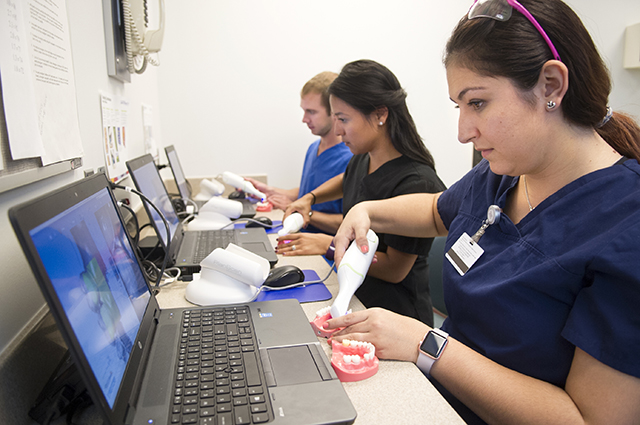CAD/CAM before clinic

Dental students are using this technology as early as their D2 year, thanks in part to a gift from the Texas A&M Association of Former Students
The use of CAD/CAM technology (computer-aided design and manufacturing) has been a part of the clinical curriculum at Texas A&M University Baylor College of Dentistry for more than two decades, since the technology’s reach extended into the dental field.
These systems have transformed the accessibility of efficient, precise dental restorations. A CAD/CAM unit can, in conjunction with a patient’s digital images, be used to mill crowns, veneers and fixed bridges, among other uses, all while the patient reclines in the dental chair.
Now TAMBCD students can learn how to use CAD/CAM before they even step foot in the clinic.
Second-year dental students began using scanner laptop units in the Sim Lab at the outset of the 2015-2016 academic year. With a $60,000 contribution from the Texas A&M Association of Former Students, dental school administrators were able to purchase the first unit used in the preclinical curriculum.

With oversight from Preclinical Fixed Prosthodontics course instructors Dr. Amanda Muns and Dr. Janna Burnett, second-year dental students primarily use the CAD/CAM units to scan crown preparations for milling and pore over the systems’ comparison software.
“The comparison software allows the student to scan their work and have the computer software compare it to a ‘perfect’ preparation, thus seeing the discrepancies or deficiencies in their preparation,” says Cherri Kading, director of clinical operations at TAMBCD. “It’s a great learning tool.”
Second-year dental student Bryan Moore considers the experience a way to propel his career forward come graduation in 2018.
“My father recently purchased a CAD/CAM system for his office, and the experience I am gaining at the dental school will allow me to have a smooth transition into his private practice,” says Moore.
“It has been one of my most enjoyable experiences of the D2 year,” Moore adds. “It allows us to transfer the principles of crown preparations, crown contouring and occlusion into the CAD/CAM system. It has also been a great learning tool to help assess whether you have adequate reduction on crown preparations. You can compare your preparation to the ideal preparation, and see where you have too much or too little reduction.”
While dental students are still taught how to use conventional impression materials, integrating the digital technology earlier in the dental school experience will allow students to perform more advanced treatments with the systems, says Dr. Amp Miller, professor in restorative sciences and director of curriculum.
Prior to 2015, dental students’ first introduction to CAD/CAM began the summer before senior year, with offsite training on E4D Technologies and Cerec systems. Fourth-year students then use the technology on select cases, collectively performing up to 300 CAD/CAM restorations a year in general dentistry alone. Plans to expand CAD/CAM in the clinic could mean more digital, rather than conventional, impressions.
The $60,000 used to purchase the two additional CAD/CAM units is the second gift from the Association of Former Students. In 2014, a $54,000 contribution allowed TAMBCD to purchase Isolite systems for use in its clincs.